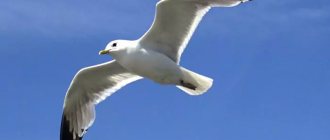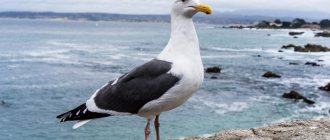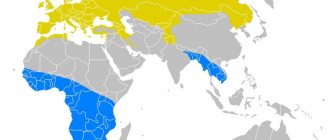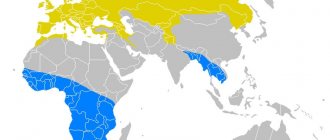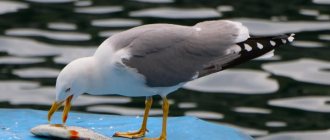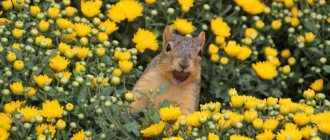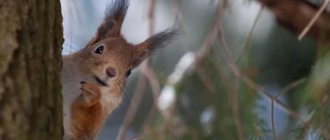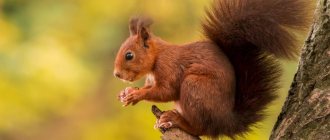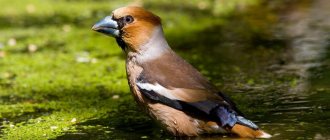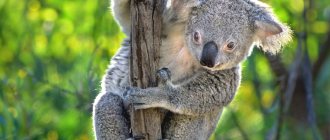From the memory of the seagull bird, the sea immediately appears before my eyes. It is with him that these wonderful birds are associated.
When talking about seagulls, the sea immediately comes to mind, because it is there, on the coast, that you are guaranteed to meet these birds - moreover, on any of the continents.
Few people know that seagulls, having their own genus and family according to biological classification, nevertheless belong to the order Charadriiformes. Depending on their permanent “registration”, they can be either migratory (flying away to warmer weather during the cold season) or sedentary.
The Legend of the Seagulls
There are many beliefs and legends about birds in people's lives. For example, the swan princess. The pink gull is the most famous from this angle.
According to legend, these are beauties punished by a witch for their attractiveness. They were drowned in rose-colored water. Their souls were reborn into pink seagulls and appeared in the sky. Now they help lost travelers.
Reproduction
The great sea gull arrives at the nesting grounds relatively early: in the Baltic Sea in March, in the north in April. These birds appear in pairs, which are apparently constant with her; They usually nest in colonies of several dozen pairs. At the beginning of May, mating games are observed and soon the construction of nests, which are located on rocks or a flat bank, often in tall grass. They are built from twigs, grass, algae, usually lined with feathers, sometimes lined with pebbles, fragments of shells, etc. The clutch consists of 2-5, most often 3 eggs, which are laid in May - June. Both parents incubate them for 26-30 days, starting from the laying of the first egg, so the chicks do not hatch at the same time. Both parents feed them, starting from the second or third day after hatching, with semi-digested burps, which are placed in front of the chick. The chicks develop relatively slowly: at the age of a week they develop stumps, and at the age of 25 days they develop a feather plume, in which only remnants of fluff are retained. They fly on the wing at the age of about 45 days, but begin to fly well only at about two months of age. But even after this, the broods stay together until they depart or migrate. For example, on the Murmansk coast the entire breeding period takes about three months: from mid-May to mid-August. Autumn migration in the northern parts of the range occurs in the second half of August - September, in the southern parts - in November.
Behavioral characteristics of seagulls
The image of seagulls in paintings or their real flight has a calming, sometimes even bewitching effect on a person.
But in fact, this just indicates that the seagull is full. Where the seagull lives, there is food. She hovers above the water with a feeling of satisfaction, because there is still a lot of food in the water below her. The bird is in comfortable conditions and is calm for itself and for its family.
But when these conditions change, the seagull very quickly turns into a greedy predator, ready to fight any rival for its prey. An interesting fact is that this behavior is typical for both adult birds and fledgling chicks.
The danger of seagulls unites. Sensing a strong enemy, the birds fly together in the blink of an eye. They fight the enemy together. They even have a special signal.
Spreading
The sea gull is widespread in the northern part of the Atlantic Ocean from Greenland and Nova Scotia to Labrador in America, Iceland, Scandinavia, Britain, France, and the Baltic Sea. In Russia it is found on the Murmansk coast and adjacent islands, on Kain, east to Vaygach and, perhaps, to the Pechora delta. From the northern parts of its range it flies south for the winter, reaching the Mediterranean Sea; in the southern parts it makes only minor migrations. The sea gull is usually associated with the sea, it inhabits rocky sea coasts and is only occasionally found on the shores of lakes. Outside the breeding season, it stays at sea near the coasts, and occasionally flies to fresh inland bodies of water. Throughout the 20th century, an increase in the number and expansion of the range of the great sea gull was recorded almost everywhere.
What do seagulls eat?
These free birds obtain food easily and naturally. The structure of their beak helps them carry out their hunt.
With its thin and sharp beak it catches its prey, which simply has no chance of escape. No matter how slippery the seagull’s main delicacies, fish or squid, turn out to be, its tenacious beak will not let go of them.
It happens that a seagull feeds on the leftover food of larger hunters, such as dolphins, whales and other marine life. But before that, she has to track for a long time and try not to miss this moment.
To get food, a seagull can fly vast distances, circling over the surface of the water. She can fly great distances from the flock, constantly observing what is happening under the water column.
Schools of fish swimming along the surface become their easy prey. But the seagull cannot dive into the depths for prey. Sometimes seagulls feed on the carcass of mollusks, fur seals, crabs and other carrion.
Those flocks that live in the steppes feed on voles and various types of plants.
It turns out that the seagull adapts to its habitat and feeds on what suits it.
Of course, there is an opinion that the seagull is dangerous for the environment. She destroys the fish. But she cleans the coast from carrion.
Double opinions with reasoned arguments will always be heard. But it’s impossible to imagine the sea coast without the cries of seagulls.
Origin of the species and description
The gull genus belongs to the gull family and includes several dozen species that differ from each other in size (sometimes tens of times), color, habitat, preferred food, and much more. It was described back in 1758 by Carl Linnaeus under the name Larus. Two most characteristic species can be distinguished: the first is the common gull, also known as the lake gull, and the second is the sea gull. Lake fish are much smaller in size and live in fresh water bodies. Their scientific description was also made by Linnaeus in 1766, the name in Latin is Larus ridibundus.
Sea gulls are large and live close to the seas; they were described by the same Linnaeus in 1766 under the name Larus marinus. In total, the gull genus includes 23 species; previously some others were also included in it, but after genetic research they were transferred to related genera. The most ancient birds inhabited the Earth about 150-160 million years ago, but gulls are a much younger family. Its most ancient fossil representatives found lived on our planet after the great extinction at the end of the Cretaceous period - approximately 50-55 million years ago.
Apparently, they were among the families formed due to the fact that as a result of this extinction, many ecological niches were vacated, which were occupied by the descendants of the survivors, including birds. But even then it was far from the appearance of the seagulls themselves - the most ancient of them inhabited the Earth approximately 7-12 million years BC. Chaikovs are generally characterized by dynamic evolution: this group quickly adapted to life near water. At first these were inland reservoirs, and then they began to develop the seas. Gradually they received more and more evolutionary adaptations for life near and in water, and this process cannot yet be considered complete.
But what they definitely did was conquer most of the Earth, starting to settle from two centers: the remains of the oldest populations of gulls were discovered in Central Asia and South America. They succeeded in this thanks to their high fertility and ability to adapt.
Photos of seagulls
Lifespan
Birds live in natural conditions for about 25 years. By the age of 30 they are considered to be long-lived. The gull bird numbers more than 200,000 specimens, so they are not in danger of becoming extinct and disappearing from our planet.
On the contrary, the number is constantly increasing and new areas are being populated. This is explained by the fact that people do not hunt it, and the seagull has only a few enemies.
ARTICLE 2:
Mongoose animal (lat. Mungos mungo)
Dangers
Despite the ability to move quickly, instantly react to danger and warn relatives of its approach, seagulls often become tasty prey for predators: bears, falcons, kites, foxes, arctic foxes.
For many centuries, seagulls lived in harmony with nature, never being a threat to any ecosystem. But due to the rapid decline of fish in water bodies, seagulls began to be considered the main reason for this. The result is that in recent decades birds have begun to be exterminated en masse.
Important! To exterminate a large number of seagulls, they are given a poisoned bird, then the nests are destroyed.
Of course, everyone understands that due to the consumer lifestyle of modern man, he wants to take the maximum from nature, returning only garbage, plastic, and chemicals to its depths. The normal balance of flora and fauna is rapidly deteriorating, and fish, which depend on the purity of the water, cannot tolerate new living conditions.
In fact, seagulls do more good than harm. Ornithologists call them sea orderlies, because seagulls love to feast on waste and the remains of discarded food. Today, some species of gulls are listed in the Red Book, for example, Chinese, red-headed or pink.
If action is not taken to protect seagulls soon, several species will disappear forever. The only option is not to disturb their usual way of life, not to exterminate birds for the sake of incorrect beliefs. According to another scenario, seagulls will leave some territories, settling on deserted islands and abandoned areas.
HomeFlora and faunaBirds of the Black Sea Black Sea gull
Sunbathers while walking meet these graceful birds everywhere - swimming in the Black Sea in flocks or each separately along the shore: in a dazzling blue sky and suddenly quickly falling into the water for prey in the form of a silvery fish, a gaping small crab, a shrimp: on the very shore - with his feet firmly holding a rapana shell that has just been thrown onto the sand and with his strong beak pulling out of it a delicious mollusk, simply oversaturated with protein beneficial to the body. Seagulls, although they are constantly close to people, are still quite shy. When you approach, they will certainly fly to the side, but in no case will they let go of their prey. So they will fly with her from place to place until they get tasty food. By the way, local crows are also accustomed to rapan. They will also be discussed in a separate chapter. But let’s return, however, to the seagulls...
Sometimes they allow vacationers to get as close as possible to them. This is the case if they came to feed them... They quickly grab the pieces of bread thrown to them and fly away, afraid that their companions will suddenly pounce on them and take away their tasty prey. Then they return to nursing again. Some holidaymakers like to throw pieces not on the ground, but in the air above the sea. And then a fantastic picture appears before them - how dexterous these birds are; not a single piece will fall into the water - it will be picked up by the seagulls and quickly carried away.
After resting and sunbathing, holidaymakers quite deliberately leave some of their food on the shore. And seagulls actively take advantage of this. They pick it up and send it into their stomachs down to the smallest crumb. And at sunset you can observe an equally fantastic picture when, gathering in large flocks, seagulls fly away to their native estuaries, where they spend the night in safety, so that early in the morning they will fly back to the sea to feed. By the way, seagulls also give birth to offspring in reliable shelters on estuaries - in reeds, on small islands and also in dense thickets.
In the off-season, our guests, vacationing and undergoing treatment in sanatoriums, boarding houses and holiday homes, open all year round, are greatly surprised by the huge number of seagulls. On the sea surface, far from the shore, entire dazzling white fields of thousands and thousands of seagulls appear before their eyes under the bright and warm sun, even in winter! But you shouldn’t be particularly surprised by such a magnificent picture. The great congregation of birds does not only consist of local gulls. Their relatives flew in for the winter from various parts of Russia, as well as large and small bodies of water in countries near and far abroad. Experts say that in the midst of wintering here you can see gulls from Balkhash, and from the Caspian and Aral seas... For example, the sea dove is a small gull with a white head and surprisingly slender long legs. There is a lot of it here in the off-season. Like its relatives – black-headed gulls. However, both locals and foreigners who have flown to us from afar live and swim in sea water together. And somewhere in April, early May, the white blankets far from the shores sharply decrease in size - these are alien seagulls flying to their homeland to feed there, already in their native reservoirs and breed their offspring in their native land. But sooner or later, their grown chicks fly to our shores and spend the so-called winter here with great pleasure.
- Duck diving There is another interesting character in the sea waters off Anapa - the diving duck.
- Smart crow Actually, these easy-to-fly, quite intelligent, and most importantly, arrogantly cunning birds are not found so often in the city of Anapa, and meeting one of the representatives of these gray beasts made me laugh to tears.
- Cormorants of the Black Sea For the most part, cormorants are in close friendship with the sea. Most often you see them close to the water - on rock ledges, islands...
- Bird Petrel And what are these desperate birds, now rushing like a stone towards the water, now soaring sharply upward and as if challenging the raging elements? Search your memory and you will certainly remember - this is a petrel!
Related materials:
Bird Petrel Smart Crow Pochard Duck Black Sea Cormorants Noticed an error or outdated information? Please let us know about it

